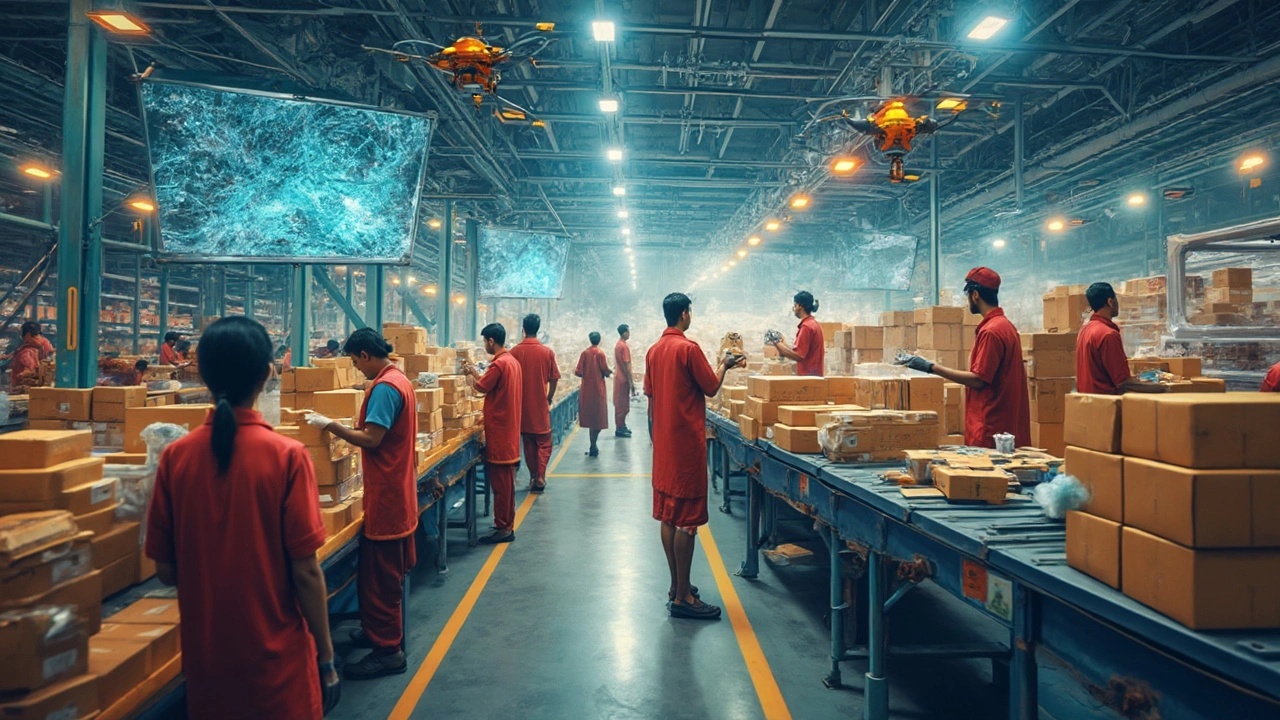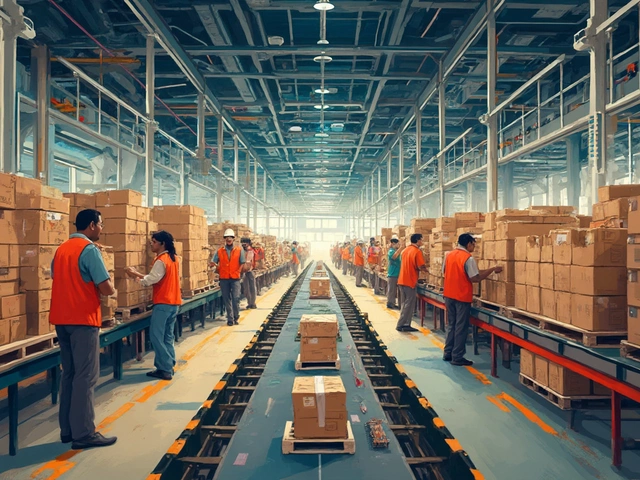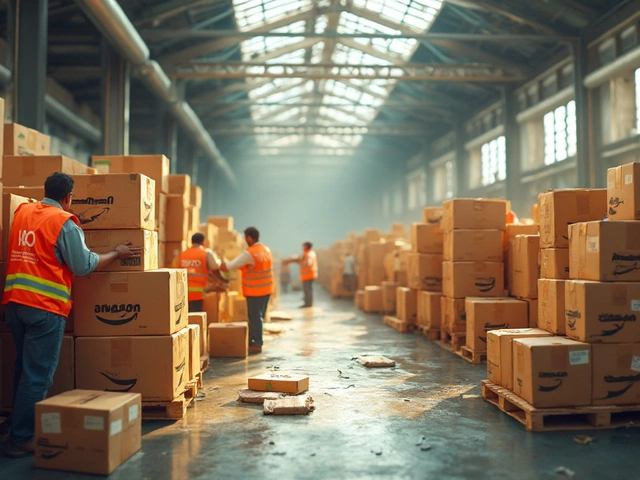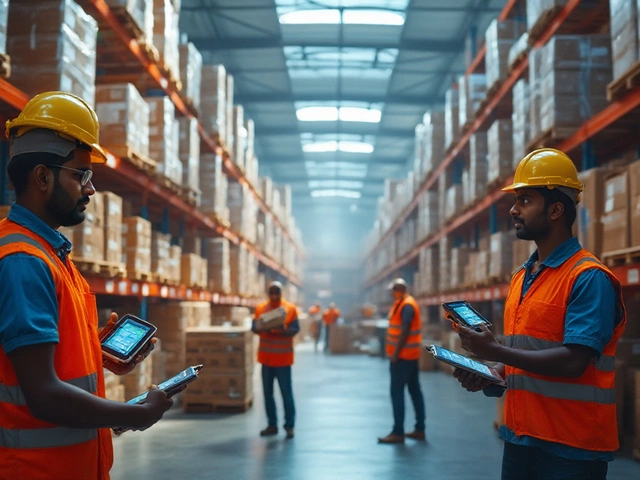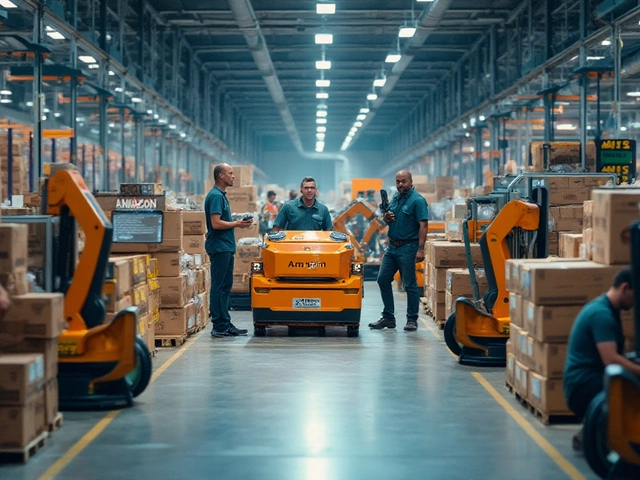Amazon didn't just become a household name overnight; it took years of relentless innovation and strategic moves. If you’ve ever marvelled at getting a package faster than you expected, Amazon's logistics network is the secret sauce. They've redefined speed and efficiency, especially in the US, with their sprawling network of fulfillment centers.
But what’s their magic formula? Well, Amazon has taken control of their entire supply chain. From developing a sophisticated warehouse system to rolling out their own delivery vans, they've topped the logistics game. And they're not stopping there; with drones and machine learning in the pipeline, Amazon is pushing boundaries further.
So, who’s trying to catch up? Companies like Alibaba and Walmart are investing heavily in their logistics to close the gap. Each has its unique play—Alibaba with its powerful data analytics and Walmart leveraging its physical stores for fulfillment. It's an exciting race to watch.
- The Rise of Amazon in E-commerce
- Amazon's Logistics Network
- Innovations in Delivery Methods
- Competitors and Their Strategies
- Impact on Customer Experience
- Future of E-commerce Logistics
The Rise of Amazon in E-commerce
The journey of Amazon from a humble online bookstore to a e-commerce giant is nothing short of legendary. Founded by Jeff Bezos in 1994 in his garage, Amazon's original vision was to be the 'Earth’s largest bookstore.' Fast forward to today, it’s the titan of e-commerce, branching out into almost any category you can think of, including tech, fashion, and groceries.
The secret sauce? Their constant focus on customer satisfaction—offering convenience, competitive pricing, and a seamless shopping experience. Remember when they introduced Prime Membership around 2005? That was a game-changer, bringing speedy shipping into the mainstream and setting new delivery expectations.
Expansion Beyond Books
By the turn of the millennium, Amazon had expanded its catalog to include electronics, toys, and even apparel. This wider selection drew in more customers, propelling their growth. They began leveraging technology, like their recommendation algorithms, to personalize shopping experiences.
| Year | Milestone |
|---|---|
| 1994 | Amazon founded |
| 1997 | Amazon goes public |
| 2005 | Launch of Amazon Prime |
| 2015 | Amazon Logistics is launched |
Innovating Logistics
Recognizing logistics as a key growth lever, they started building a robust logistics network. From strategically located warehouses to owning cargo planes, Amazon isn't just selling products; they're revolutionizing how they get to you. Their network helps reduce delivery times significantly, keeping them ahead in the e-commerce logistics race.
In the global scene, Amazon continues to innovate, taking bold steps like using drones for deliveries. As they expand into new terrains and industries, their rise isn't just an e-commerce tale; it's a testament to what relentless innovation can achieve.
Amazon's Logistics Network
Alright, let's dive into what makes Amazon an e-commerce giant when it comes to logistics. Ever wondered how they manage to deliver stuff so quickly? It's all thanks to their well-oiled, massive logistics operation. They own or rent over 150 million square feet of space across North America for their fulfillment and sortation centers. These are scattered strategically so your package doesn't have to travel across the country.
Strategic Fulfillment Centers
Amazon's fulfillment centers are like the backbone of their entire logistics empire. Imagine huge buildings, each equivalent to 28 football fields, buzzing 24/7. These centers are located based on algorithms—sounds like sci-fi but true—that predict where demand is going to be high. By having inventory close to customers, Amazon reduces delivery time significantly.
Robotics and Automation
Inside these centers, robots and humans work side-by-side. Robots do the heavy lifting and humans handle the delicate stuff. This way, they save time and reduce errors. Remember the Kiva robots they bought in 2012? Those little helpers have revolutionized how items are picked and packed. They're like the unsung heroes of Amazon’s logistics.
Last-Mile Delivery
If you've ever seen Amazon-branded vans in your neighborhood, that's part of their last-mile strategy. They’ve developed their own delivery wing, called Amazon Logistics, which employs drivers directly and contracts others through their Delivery Service Partner program. This gives them more control over the delivery process, ensuring your package arrives intact and on time.
Innovations and Future Plans
Amazon isn't stopping there. They're experimenting with drones and autonomous delivery vehicles like the Amazon Scout. These might seem like future tech, but Amazon is serious about getting them off the ground. When time’s of the essence, drones could be dropping off your orders in less than 30 minutes.
With all these pieces in place, Amazon continues to be a powerhouse in e-commerce logistics. They’re not just keeping up with the competition, they’re setting the bar sky-high.
Innovations in Delivery Methods
The world of e-commerce is fast-paced, but Amazon seems to have injected rocket fuel into its delivery strategies. Have you ever heard of same-day delivery being the norm? This wasn’t a thing until Amazon decided to shake things up. They're not just about getting it fast, but delivering smarter too.
Prime Air and Drone Deliveries
Let’s talk about drones. Amazon's Prime Air has been testing drone delivery since 2013. These flying machines aim to drop your package on your doorstep in under 30 minutes. If that sounds like something from the future, well, Amazon's making it the now. In 2023, they completed their first customer drone delivery in a suburban neighborhood—imagine watching a flying object gently deliver your latest gadget order. It's happening, folks.
Amazon Flex and On-Demand Drivers
Then there's Amazon Flex, which puts delivery into your hands... literally. This program lets regular folks with a car and a smartphone deliver packages during their free time. It's kind of like Uber for delivery. It gives Amazon the flexibility to ramp up delivery capacity without huge infrastructure costs. If you see an unusually high number of people picking up packages from their car trunks, you know why.
Electrifying the Fleet
Electric delivery vans aren't just good for the planet—they're good business too. By 2023, Amazon aimed to have tens of thousands of electric vans on the road, part of an ambitious commitment to decarbonization. This move not only reduces their carbon footprint, but also cuts long-term fuel costs in logistics.
| Year | Amazon Fleet Electrification Goal |
|---|---|
| 2021 | 10,000 electric vans |
| 2025 | 100,000 electric vans |
These innovations have ripple effects, pushing competitors to rethink their game plans. From small robots zooming along city sidewalks to autonomous vehicles, the future of delivery is more than exciting—it's already being delivered.
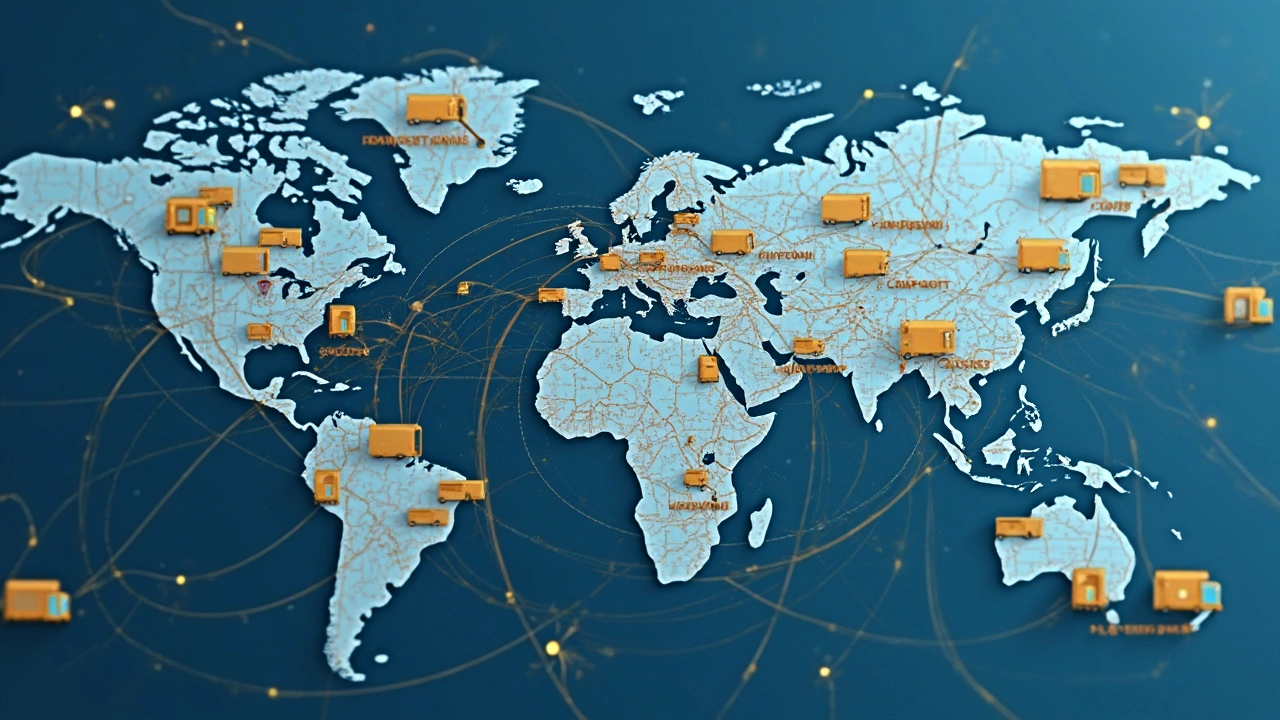
Competitors and Their Strategies
Even though Amazon sits on the throne of e-commerce, it's not without its challengers. There are a few major players in the e-commerce game trying to steal a piece of the pie and they’re doing some interesting stuff to make it happen.
Alibaba
Alibaba, the Chinese giant, approaches e-commerce differently. Instead of handling everything in-house like Amazon, they connect buyers and sellers, acting as a platform rather than a full-service provider. This strategy allows them to scale without getting bogged down by logistics operations. They invest heavily in data analytics, giving their sellers insights into consumer behavior, which is a major plus for businesses aiming to boost sales.
Walmart
Walmart’s strategy is all about leveraging its existing physical stores. They're turning these stores into mini warehouses to fulfill online orders. This 'ship from store' model means products can reach customers faster since they travel a shorter distance. Plus, Walmart offers free two-day shipping without a membership fee, which is a direct jab at Amazon Prime. It's their way of enticing those who might be on the fence about loyalty.
Shopify
Shopify isn’t competing with Amazon on the logistics front but instead empowers small and medium businesses to get in the game. They provide the tools for these businesses to set up online stores effortlessly, manage inventory, and even handle payments. By giving businesses control over their brand and customer relationships, Shopify appeals to those who want independence from giant marketplaces.
It’s not just about matching Amazon’s speed. Each of these players brings something unique to the table, and the competition keeps the e-commerce industry vibrant and ever-evolving. Who will win in the end? It might just come down to who innovates next.
Impact on Customer Experience
When it comes to improving customer experience, Amazon has mastered the art, setting a standard others can only aspire to match. With their highly efficient logistics network, they’ve turned the once uncertain wait for a package into a well-oiled process. Have you ever ordered something in the morning and found it at your doorstep by evening? Thank Amazon's rigorous logistics for that.
One thing that stands out is their exceptional reliability. By owning a significant part of their logistics, Amazon can ensure faster delivery times and fewer mishaps. Whether it’s a book, household item, or groceries through Amazon Fresh, the predictability is uncanny. It’s not just about speed; it’s the precision and convenience they offer that leaves a mark on customers.
Personalization and Tracking
Amazon takes customer experience to another level with personalization. Their system tracks user behavior to tailor experiences and suggest products, making shopping almost intuitive. And once you’ve clicked 'buy', the obsessive attention to detail doesn’t stop. Their package tracking system is second to none. You can follow your order's journey every step of the way — from the warehouse to your home. This transparency is what makes customers trust Amazon.
Changing Customer Expectations
Amazon's approach has essentially reshaped what buyers expect from e-commerce. Now, other companies are under pressure to match these expectations, whether it’s in terms of speed, reliability, or overall service quality.
Here’s something interesting: according to recent surveys, 85% of customers prefer shopping with Amazon because of the reliable delivery times and tracking features. It's not just about getting things fast, but knowing when and how they're going to arrive.
The question is, can other e-commerce players match or even exceed this level of customer satisfaction? Only time and innovative logistic strategies will tell.
Future of E-commerce Logistics
Fasten your seatbelts because the future of e-commerce logistics is coming in hot. Technologies that sound straight out of a sci-fi movie are closer than you think. Let's crack open what lies ahead for the industry.
Drone Deliveries Take Flight
One of the buzziest trends is drone deliveries. Amazon is testing them for package delivery, promising to bring packages to your doorstep in less than 30 minutes. While regulations are still catching up to the technology, the vision of skies filled with delivery drones is no longer a distant dream.
Automation Revolution
Warehouses and delivery hubs are gearing up for more automation. Think robots picking and packing orders, and autonomous vehicles handling deliveries. This not only speeds up operations but also cuts down costs. Companies investing in this automation revolution will likely lead the logistics race.
Eco-friendly Options
With environmental concerns on the rise, e-commerce companies are under pressure to reduce their carbon footprint. Expect a push towards electric delivery vehicles and efficient packaging solutions. More eco-conscious options might soon be standard practice rather than exceptions.
Data-Driven Decisions
Data analytics is stepping up in logistics. Companies harness vast amounts of data to optimize delivery routes and predict consumer demands. The result? Reduced delivery times, improved customer satisfaction, and cost savings.
| Year | Predicted Drone Market Size (Billion USD) |
|---|---|
| 2023 | 22.5 |
| 2025 | 42.8 |
As you can see, the drone market is projected to grow significantly, further influencing logistics strategies.
So, keep an eye on these trends. They might change how we shop and receive products. The future is not just knocking on the door; it’s flying through the window!
